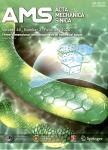The dynamical complexity of work-hardening:a large-scale molecular dynamics simulation
The dynamical complexity of work-hardening:a large-scale molecular dynamics simulation作者机构:MaxPlanckInstituteforMetalsResearchHeisenbergstrasse3D-70569StuttgartGermany CaliforniaInstituteofTechnology1201EastCaliforniaBlvd.Pasadena91125CAUSA//MaxPlanckInstituteforMetalsResearchHeisenbergstrasse3D-70569StuttgartGermany LawrenceLivermoreNationalLaboratory7000EastAve.LivermoreCA94550USA IBMAlmadenResearchCenter650HarryRoadSanJoseCA95120USA
出 版 物:《Acta Mechanica Sinica》 (力学学报(英文版))
年 卷 期:2005年第21卷第2期
页 面:103-111页
核心收录:
学科分类:07[理学] 070104[理学-应用数学] 0701[理学-数学]
基 金:University of California Lawrence Livermore National Laboratory (W-7405-Eng-48)
主 题:Work-hardening Large-scale atomistic simulation Dislocation junction Cross-slip
摘 要:We analyze a large-scale molecular dynamics simulation of work hardening in a model system of a ductile solid. With tensile loading, we observe emission of thousands of dislocations from two sharp cracks. The dislocations interact in a complex way, revealing three fundamental mechanisms of work-hardening in this ductile material. These are (1) dislocation cutting processes, jog formation and generation of trails of point defects; (2) activation of secondary slip systems by Frank-Read and cross-slip mechanisms; and (3) formation of sessile dislocations such as Lomer-Cottrell locks. We report the discovery of a new class of point defects referred to as trail of partial point defects, which could play an important role in situations when partial dislocations dominate plasticity. Another important result of the present work is the rediscovery of the Fleischer-mechanism of cross-slip of partial dislocations that was theoretically proposed more than 50 years ago, and is now, for the first time, confirmed by atomistic simulation. On the typical time scale of molecular dynamics simulations, the dislocations self-organize into a complex sessile defect topology. Our analysis illustrates numerous mechanisms formerly only conjectured in textbooks and observed indirectly in experiments. It is the first time that such a rich set of fundamental phenomena have been revealed in a single computer simulation, and its dynamical evolution has been studied. The present study exemplifies the simulation and analysis of the complex nonlinear dynamics of a many-particle system during failure using ultra-large scale computing.



